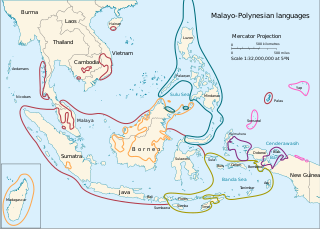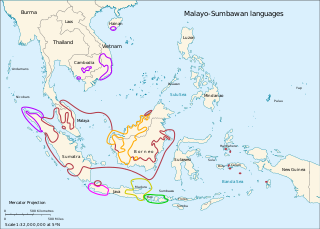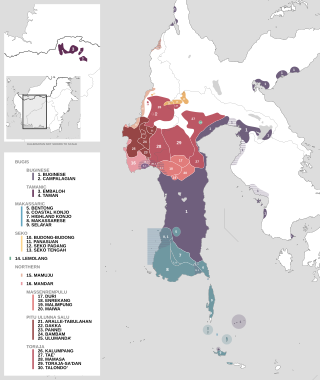Related Research Articles

The Malayo-Polynesian languages are a subgroup of the Austronesian languages, with approximately 385.5 million speakers. The Malayo-Polynesian languages are spoken by the Austronesian peoples outside of Taiwan, in the island nations of Southeast Asia and the Pacific Ocean, with a smaller number in continental Asia in the areas near the Malay Peninsula, with Cambodia, Vietnam and the Chinese island Hainan as the northwest geographic outlier. Malagasy, spoken in the island of Madagascar off the eastern coast of Africa in the Indian Ocean, is the furthest western outlier.

The Malagasy are a group of Austronesian-speaking ethnic groups indigenous to the island country of Madagascar. Traditionally, the population have been divided into ethnic groups. Examples include "Highlander" groups such as the Merina and Betsileo of the central highlands around Antananarivo, Alaotra (Ambatondrazaka) and Fianarantsoa, and the "coastal dwellers" such as the Sakalava, Bara, Vezo, Betsimisaraka, Mahafaly, etc.
Barito may refer to:

The Malayic languages are a branch of the Malayo-Polynesian subgroup of the Austronesian language family. The most prominent member is Malay, a pluricentric language given national status in Brunei and Singapore while also the basis for national standards Malaysian in Malaysia and Indonesian in Indonesia. The Malayic branch also includes local languages spoken by ethnic Malays, further several languages spoken by various other ethnic groups of Sumatra, Indonesia and Borneo even as far as Urak Lawoi in the southwestern coast of Thailand.
The Ibanic languages are a branch of the Malayic languages indigenous to western Borneo. They are spoken by the Ibans and related groups in East Malaysia and the Indonesian province of West Kalimantan. Other Dayak languages, called Land Dayak, which are not Ibanic, are found in the northwest corner of Kalimantan, between Ibanic and non-Ibanic Malayic languages such as Kendayan and the Malay dialects of Sarawak and Pontianak.
The East Barito languages are a group of a dozen Dayak (Austronesian) languages of Borneo, Indonesia, and most notably Malagasy, the national language of Madagascar. They are named after the Barito River located in South Kalimantan, Indonesia.
The Kayanic or Kayan–Murik languages are a group of Austronesian languages spoken in Borneo by the Kayan, Morek Baram, Bahau, and related peoples.

The Sama–Bajaw languages are a well-established group of languages spoken by the Sama-Bajau peoples of the Philippines, Indonesia and Malaysia.
The Minahasan languages are a subgroup of the Austronesian languages spoken by the Minahasa people in northern Sulawesi, Indonesia. They belong to the Philippine subgroup.
The Greater North Borneo languages are a proposed subgroup of the Austronesian language family. The subgroup historically covers languages that are spoken throughout much of Borneo and Sumatra, as well as parts of Java, and Mainland Southeast Asia. The Greater North Borneo hypothesis was first proposed by Robert Blust (2010) and further elaborated by Alexander Smith. The evidence presented for this proposal are solely lexical. Despite its name, this branch has been now widespread within the Maritime Southeast Asia region.

The Malayo-Sumbawan languages are a proposed subgroup of the Austronesian languages that unites the Malayic and Chamic languages with the languages of Java and the western Lesser Sunda Islands, except for Javanese. If valid, it would be the largest demonstrated family of Malayo-Polynesian outside Oceanic. The Malayo-Sumbawan subgroup is however not universally accepted, and is rejected e.g. by Blust (2010) and Smith (2017), who supported the Greater North Borneo and Western Indonesian hypotheses. In a 2019 paper published in Oceanic Linguistics, Adelaar accepted both of these groupings, in addition to Smith's (2018) redefinition of Barito languages as forming a linkage.
The Bali–Sasak–Sumbawa languages are a group of closely related languages spoken in Indonesia in the western Lesser Sunda Islands. The three languages are Balinese on Bali, Sasak on Lombok, and Sumbawa on western Sumbawa.
The Sabahan languages are a group of Austronesian languages centered on the Bornean province of Sabah.

The South Sulawesi languages are a subgroup of the Austronesian language family. They are primarily spoken in the Indonesian provinces of South Sulawesi and West Sulawesi, with a small outlying pocket in West Kalimantan.

Malagasy is an Austronesian language and dialect continuum spoken in Madagascar. The standard variety, called Official Malagasy, is an official language of Madagascar alongside French.

Ma'anyan, Dayak Maanyan or Eastern Barito Dayak people are an ethnic group of the Dayak people indigenous to Borneo. They are also considered as part of the east Barito Dusun group with the name Dusun Ma'anyan. According to J. Mallinckrodt (1927), the Dusun people group is part of the Ot Danum people cluster, although later that theory was disproved by A. B. Hudson (1967), who argues that the Ma'anyan people are a branch of the Barito family. The Ma'anyan people who are often referred to as Dayak people are also referred to as Dayak Ma'anyan. The Dayak Ma'anyan people inhabit the east side of Central Kalimantan, especially in the East Barito Regency and parts of South Barito Regency which are grouped as Ma'anyan I. The Dayak Ma'anyan people also inhabit the northern parts of South Kalimantan, especially in Tabalong Regency which refers to the Dayak Warukin people. The Dayak Balangan people or Dusun Balangan people which are found in the Balangan Regency and the Dayak Samihim people that are found in the Kotabaru Regency are grouped together with the Dayak Ma'anyan people group. The Dayak Ma'anyan people in South Kalimantan are grouped as Ma'anyan II.
Maanyan or Maʼanyan is an Austronesian language belonging to the East Barito languages. It is spoken by about 150,000 Ma'anyan people living in the province of Central Kalimantan and South Kalimantan, Indonesia. It is most closely related to the Malagasy language spoken in Madagascar, although these languages are not mutually intelligible due to geographical distance.
The Tamanic languages are a small group of languages of Kapuas Hulu Regency, West Kalimantan:

Indonesia–Madagascar relations spans for over a millennium, since the ancestors of the people of Madagascar sailed across the Indian Ocean from the Nusantara Archipelago back in 8th or 9th century AD. Indonesia has an embassy in Antananarivo, while Madagascar does not have an accreditation to Indonesia. It was announced in December 2017 that Madagascar would be opening an embassy in Jakarta in 2018, however, the embassy was never opened.
Dusun Balangan language or Halong language is one of the Dayak languages spoken by the Halong Dayak people in the Balangan Regency, South Kalimantan, and in the village of Tanjung Pinang, Paser Regency, East Kalimantan, Indonesia.
References
- ↑ Hudson, Alfred B. 1967. The Barito isolects of Borneo: A classification based on comparative reconstruction and lexicostatistics. Data Paper no. 68, Southeast Asia Program, Department of Asian Studies, Cornell University. Ithaca, N.Y.: Cornell University,
- ↑ Blust, Robert (2013). The Austronesian languages. Asia-Pacific Linguistics 008 (Revised ed.). Canberra: Asia-Pacific Linguistics, Research School of Pacific and Asian Studies, The Australian National University. p. 743. hdl:1885/10191. ISBN 978-1-922185-07-5. OCLC 851066712.
- 1 2 Adelaar, K. Alexander (2006). "Borneo as a Cross-Roads for Comparative Austronesian Linguistics". In Bellwood, Peter; Fox, James J.; Tryon, Darrell T. (eds.). The Austronesians: Historical and Comparative Perspectives. Canberra: ANU E Press. pp. 81–102. doi: 10.22459/A.09.2006.04 . ISBN 1-920942-85-8. JSTOR j.ctt2jbjx1.7. OCLC 225298720.
- ↑ There are also some Sulawesi loanwords, which Adelaar attributes to contact prior to the migration to Madagascar: See K. Alexander Adelaar, “The Indonesian Migrations to Madagascar: Making Sense of the Multidisciplinary Evidence”, in Truman Simanjuntak, Ingrid Harriet Eileen Pojoh and Muhammad Hisyam (eds.), Austronesian Diaspora and the Ethnogeneses of People in Indonesian Archipelago, (Jakarta: Indonesian Institute of Sciences, 2006), pp. 8–9.
- ↑ Dewar, Robert E.; Wright, Henry T. (1993). "The culture history of Madagascar". Journal of World Prehistory. 7 (4): 417–466. doi:10.1007/bf00997802. hdl: 2027.42/45256 .
- ↑ Burney DA, Burney LP, Godfrey LR, Jungers WL, Goodman SM, Wright HT, Jull AJ (August 2004). "A chronology for late prehistoric Madagascar". Journal of Human Evolution. 47 (1–2): 25–63. doi:10.1016/j.jhevol.2004.05.005. PMID 15288523.
- ↑ Kumar, Ann (2012). 'Dominion Over Palm and Pine: Early Indonesia’s Maritime Reach', in Geoff Wade (ed.), Anthony Reid and the Study of the Southeast Asian Past (Singapore: Institute of Southeast Asian Studies), 101–122.
- ↑ Adelaar, K. Alexander (1995). "Asian Roots of the Malagasy: A Linguistic Perspective". Bijdragen tot de Taal-, Land- en Volkenkunde / Journal of the Humanities and Social Sciences of Southeast Asia. 151 (3): 325–356. doi: 10.1163/22134379-90003036 . ISSN 0006-2294. JSTOR 27864676. OCLC 5672481889.
- ↑ Adelaar, K. Alexander (2017). "Who Were the First Malagasy, and What Did They Speak?". In Acri, Andrea; Blench, Roger; Landmann, Alexandra (eds.). Spirits and Ships: Cultural Transfers in Early Monsoon Asia. Book collections on Project MUSE 28. Singapore: ISEAS-Yusof Ishak Institute. pp. 441–469. doi:10.1355/9789814762779-012. ISBN 978-981-4762-75-5. OCLC 1012757769.
- ↑ Adelaar, K. Alexander (2016). "A Linguist's Perspective on the Settlement History of Madagascar". NUSA: Linguistic studies of languages in and around Indonesia. 61: 69–88. doi:10.15026/89605. hdl:10108/89605. ISSN 0126-2874. OCLC 1005142867.
- ↑ Blust, Robert. 2006. 'The linguistic macrohistory of the Philippines'. In Liao & Rubino, eds, Current Issues in Philippine Linguistics and Anthropology. pp 31–68.
- ↑ Smith, Alexander. 2017. The Languages of Borneo: A Comprehensive Classification . PhD Dissertation: University of Hawai‘i at Mānoa.
- ↑ Smith, Alexander D. 2018. The Barito Linkage Hypothesis, with a Note on the Position of Basap. JSEALS Volume 11.1 (2018).
- ↑ Bamba, John (ed.) (2008). Mozaik Dayak keberagaman subsuku dan bahasa Dayak di Kalimantan Barat. Pontianak: Institut Dayakologi. ISBN 978-979-97788-5-7.
- ↑ Istiyani, Chatarina Pancer (2008). Memahami peta keberagaman subsuku dan bahasa Dayak di Kalimantan Barat. Institut Dayakologi.